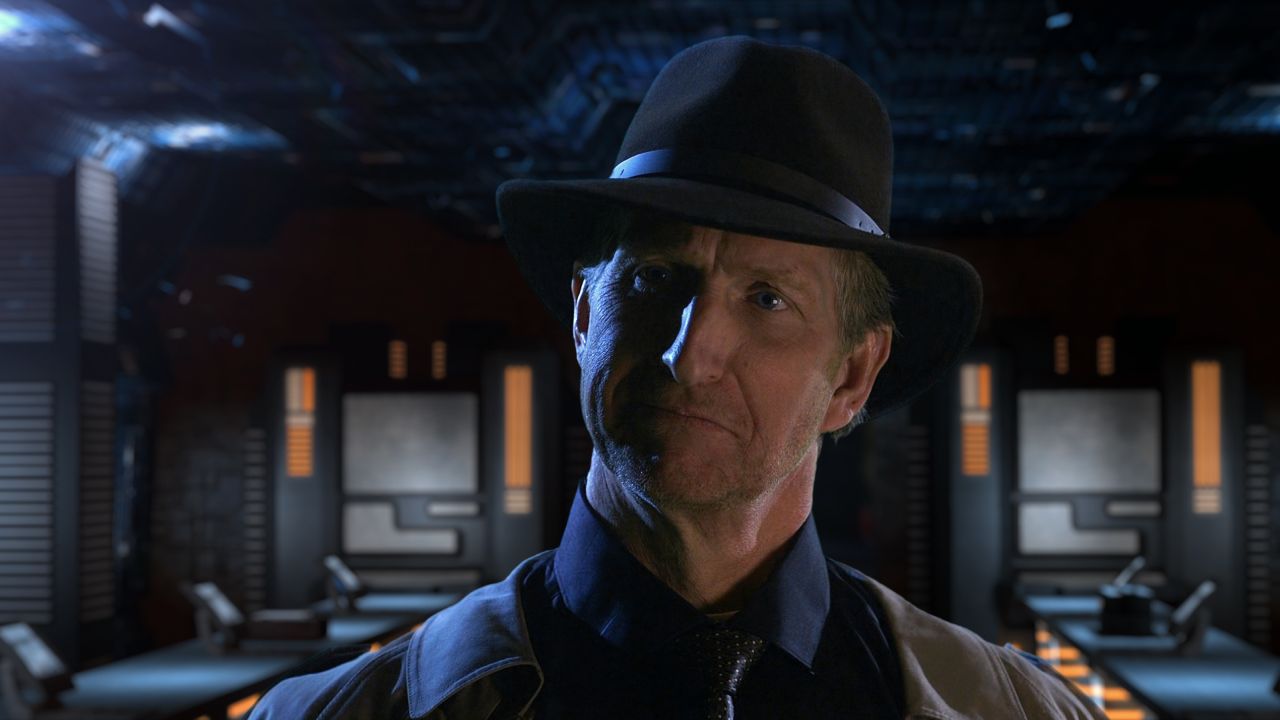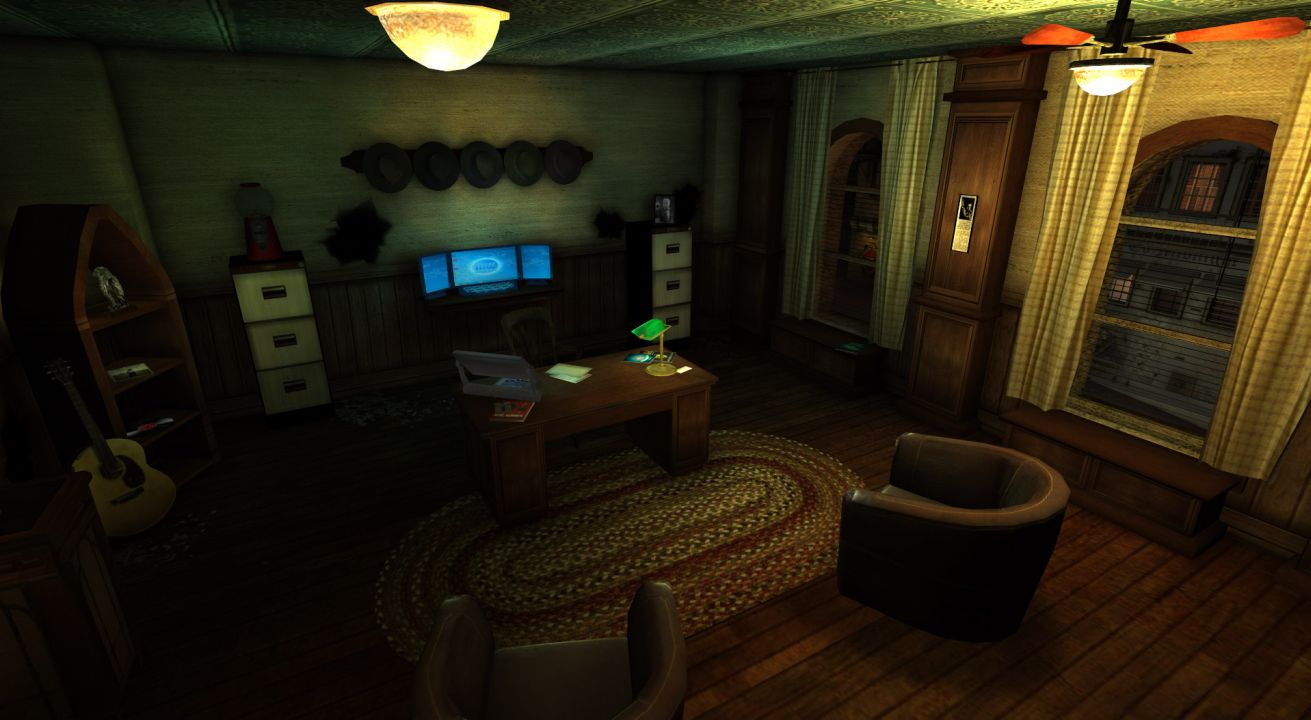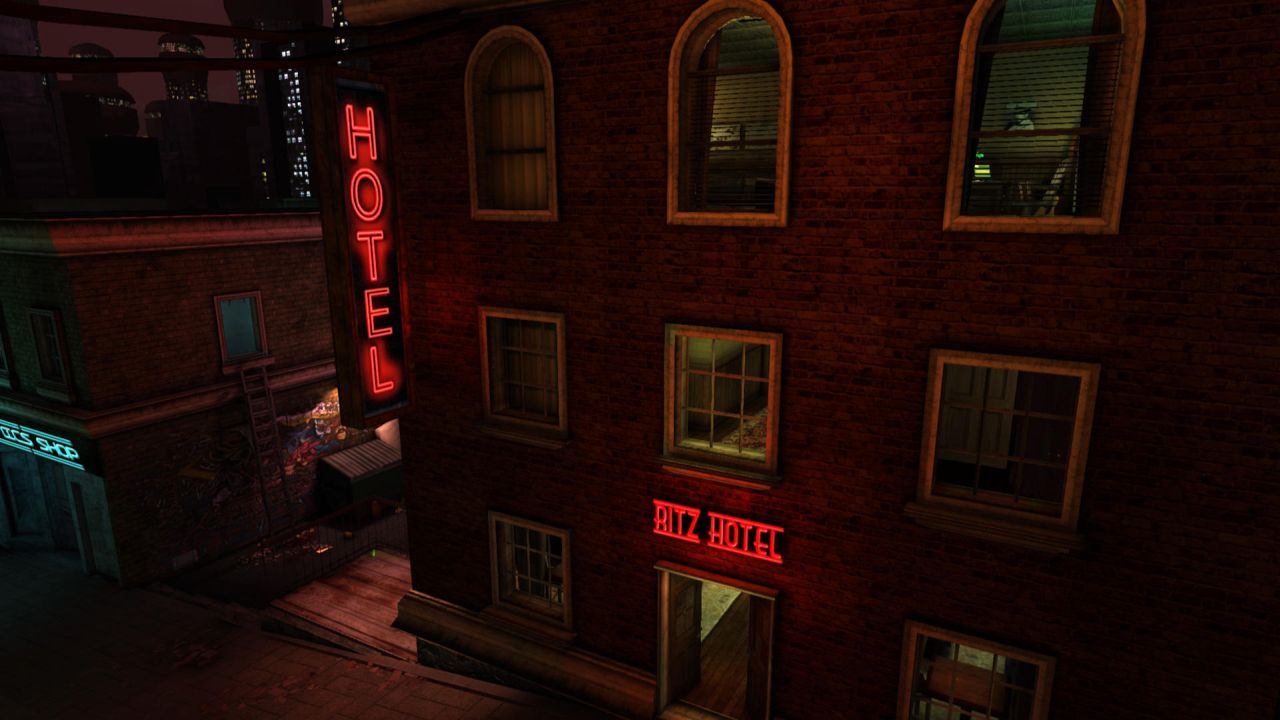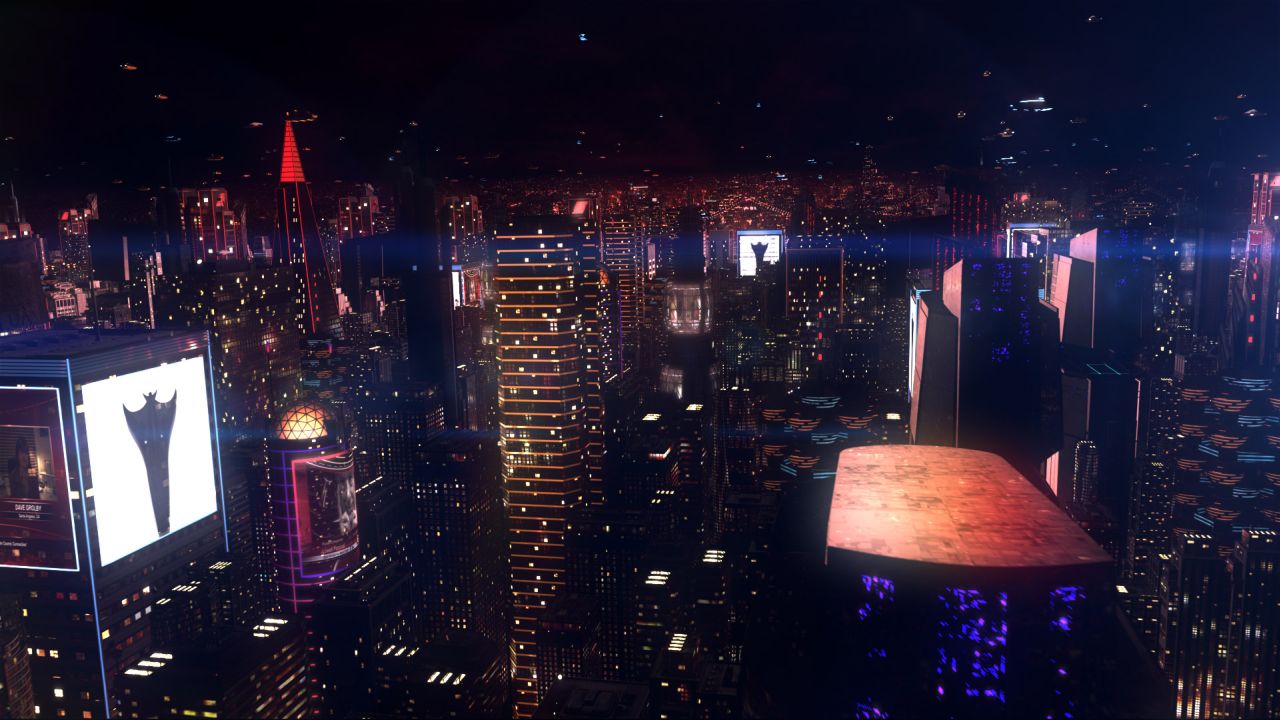Tesla Effect Review
Alright, I knew nostalgia was a powerful force, but did anybody really want to see a return of FMV adventure games this badly? Evidently nearly ten thousand people, judging by the success of the Kickstarter behind our subject today, but I’m worried that they’re all kept in a secret facility somewhere in the Mojave desert and subsist entirely on experimental lab-grown proteins or something. Why anybody would get nostalgic enough to try to actively revive a design practice rooted in watching poorly-acted video instead of participating in gameplay is beyond me. I’m sure it was all very impressive in the 1990s when compact discs were a thing and your games could suddenly play video instead of flashing up scrolling text screens every now and then, but we can make in-game cinematics now, you know. FMV – or, if you haven’t Googled it yet, Full Motion Video – is a product of a bygone age, like writing the exposition in the tatty booklet that came with the game; an awkward, wedged-in way of introducing a tighter story focus that slunk off to die as technology improved and Half-Life descended from Mount Olympus to show how storytelling ought to be done.

So, for reasons that the clever clogs among you have already guessed, I was more than a wee bit wary of Tesla Effect, the sixth instalment of the FMV-laden Tex Murphy games. It seemed to embody the philosophy of deliberately bringing back things that have no place in this decade, partially FMV but also the Tex Murphy series itself. The hammy mockery of film-noir, the impractical sci-fi elements, the comic-relief narrator and the so-called ‘mutants’ that consist of regular people in progressively more elaborate makeup might’ve seemed a tad cheesy when Duke Nukem was considered an acceptable videogame protagonist, but by today’s standards the cheese has shot right through three or four levels of irony and disappeared off the scale entirely, leaving only a sticky yellow smear behind. Still, though it would have been gratifying to see the series grow up and confront its own absurdity, I might be getting a bit hasty with the thumbscrews here. After all, it beats the trousers off the standard route of making an unbearably gritty reboot with all the charm and character caked under layers of mascara (alright, alright, I promise I’ll let go of this soon), and there is something to be said for a series that stubbornly refuses to budge an inch from the background in which it was born. It’s like a little window into the past – perhaps not a past we want to remember, but a past nonetheless.
So, let me paint the scene. Tex Murphy, still the lovably incompetent private-eye living in a nightmarish dystopian future-city as envisioned by the radical day-glo nineties, wakes up on the fire escape outside his office with a head injury, seven years of his life missing, and a bout of amnesia swilling around in his brain instead of coherent memories. Whoops! Now, that’s not what you’d call a promising return to form, is it? Why amnesia? It, like the kidnapped love interest or the magical MacGuffin, is a videogame storytelling trope so old and shrivelled that if you put it on a fruit stall you’d be reported for propagating malnutrition. It’s obvious why writers keep using it – because it’s infinitely easier to let a player inhabit a blank slate and let them learn alongside the character than have them deal with an existing knowledge base – but is there really no better way of connecting this game to its predecessor? I mean honestly, this is a Tex Murphy game we’re talking about. With the tone you’re dealing with here, you could probably get away with knocking Tex over the head with a giant novelty mallet if you framed it properly. Maybe – given that it’s been sixteen years since the cliffhanger ending of Overseer, the last Tex Murphy game – this is supposed to garner a kind of solidarity with all the people whose memories of the nineties have long since faded into a cloudy miasma.

Tex is nothing if not an enthusiastic private-eye, though, so rather than sitting up in a hospital bed for six months undergoing futuristic therapy, he immediately sets about investigating the circumstances surrounding his amnesia, and quickly discovers events afoot that are far more significant than the bruise on his forehead. The writing certainly feels very film-noir at times, full of characters that are introduced once before being lost in a sea of shifting motivations and allegiances, but the actual overarching plot is an insane conspiracy sci-fi concerning the lost works of Nikola Tesla, best known for making lightning bolts arc off things, being intrinsically superior to Thomas Edison and, if this game is to be believed, attempting to communicate with the dead. The resulting tone lands somewhere between The Maltese Falcon and Ghostbusters, and as fundamentally bizarre as it is, it’s hard to dislike the game for it when it’s so gleefully off-the-wall. If anything, my complaint is that the game quickly escalates to a point where it has just a bit too much going on at once. There’s the Tesla documents, but there’s also a new kind of mutant that we don’t really see, a cryogenic container that might contain somebody’s brain or might be totally empty, a missing neurologist, Tex’s probably-dead girlfriend, a new love interest who he was working with pre-amnesia who might be a little bit psycho, and a bloke from the 1940s who might have been Tex in a previous life but might’ve been an ancestor. Like I said, Tesla Effect doesn’t really keep any notes, other than the hint system which tells you how to progress to the next part of the story, so it can be difficult at times to piece together everything into something that makes sense. I suppose it wouldn’t be a proper detective story unless we were kept in the dark a little bit. At any rate, fans of the series probably don’t have to worry about it losing its touch.
And boy oh boy, Tesla Effect loves its fan-service. Not the kind of fan-service that leaves female characters wearing skin-tight leather outfits that leave not nearly enough to the imagination – although that does come up once or twice, funnily enough – but the kind that takes every opportunity possible to indulge in self-congratulatory parading of the series just for the sake of the fandom. Often I’d click on what looked like a useful puzzle item only to hear Tex launch into a reminiscence about how this particular lead pipe contributed to Under A Killing Moon, followed by a cinematic from the 1994 game showing him getting beaten senseless by that shape-shifting bloke. I’m fine with being proud of your work, and it doesn’t get in the way of gameplay or anything, but it is slightly nauseating having to interact with a product that thinks it’s okay to just wave references in front of the player and go “hey kids, remember this?” There’s a building on Chandler Avenue full of pictures of what I can only presume are the developers – which might have been a clever little addition if it had been presented as some kind of obscure secret area, rather as a place that you can simply walk into – and even an annoying fan in the game, whose devotion to Tex is just enough to become grating but not enough to do his hero a favour without first receiving an arbitrary item. Oh, but of course.

Gameplay is virtually unchanged from where we left off in 1998, with the exception that mouse-look is no longer an arcane, barely-understood technique of questionable usefulness and reliability. What that means is that you’ll spend part of your time navigating dialogue trees, part of your time solving puzzles, and an enormous Pac-man-shaped slice of your time aimlessly wandering around hoovering up every loose item in sight. It feels deliberately old-fashioned, which isn’t necessarily a bad thing in itself, but like the bearded chap who rides a Penny-Farthing bicycle around your university campus, you quickly get the sense that it’s doing it for the novelty more than anything else. I won’t apologise for being used to having a list of notes and objectives on-hand at all times, for instance, and floundering hopelessly in their absence.
One change I’m not so fond of – something that seems to be turning up in an awful lot of modern adventure games, but here’s my chance to really whine about it – is that you have just two actions: ‘look’ and ‘use’. ‘Use’ functions as an all-purpose button that automatically does whatever the most appropriate action is, whether it’s picking up a small item, activating a mechanism, opening a container, pushing a crate or replacing a damaged hover-car manifold in the snow using only your toes (spoiler: that doesn’t actually happen), and I find that this puts something of a disappointing limitation on the complexity of the puzzles. Sure, it’s more streamlined, but part of the beauty of point-and-click adventures – and, more so, the graphical text parser adventures that preceded them – was that they required you to express exactly what you wanted to do, which ‘use’ negates. What do you mean, ‘use’ this item? Should I push it? Pull it? Steal it? Wear it as a hat? Oh, it opens it. I’m glad that Tex possessed the necessary psychic intuition to just know that’s what he needed to do, but I can’t help but feel that part of the puzzle here is just being done for me. It’s even possible to just run around clicking on every interactive element in sight, brute-forcing large chunks of the puzzles as a result. Try ‘use’ in an old text adventure and watch it acknowledge your input just long enough to spit in your eye in disgust.

Also, while the adventure game puzzles themselves are usually fairly intuitive (take a look, Ether One), every now and then Tesla Effect resorts to what I like to call ‘action game’ puzzles: a catalogue of generic puzzles that can be easily slotted into any action game, bringing the pacing to a halt like a dead kangaroo on an unlit country road. It doesn’t matter if they’re ‘Simon Says’, sliding some blocks, reflecting a beam of light or just finding a bunch of arbitrarily placed switches (I have “two more to go, one more to go, sequence completed” permanently burned into the inside of my eyelids), they’re all unimaginative and utterly contrived. At one point there I encountered a particularly obnoxious tile-sliding puzzle – sitting above a mantelpiece, because videogame logic – which would, when solved, reveal a code on its surface. Out of interest I looked up the most effective method of solving it, and apparently the only real way is brute force and patience. Brute force, you say? Would that be the kind of method involving the screenshot button and several minutes in Photoshop?
Goodness me, what am I thinking? Is this a bloody FMV game or what? Yes, yes, yes, but the fundamental problem with FMV is that it is only understood in terms of the mysterious eldritch language of film-making; of lights, cameras, actors, costumes, cues and green-screens. As somebody who wouldn’t know a jump-cut if it leapt out of a hedge and tweaked my nose with a set of pliers, what meaningful comment can I really offer here? Chris Jones returns to the role of Tex, a little bit worn by the turn of the century but no less deadpan, and the rest of the cast is well-acted enough to stay believable. Costumes and special effects can occasionally look a bit low-budget, but I find that gives them a certain modicum of amateurish charm not unlike that of an old Doctor Who episode. Of course, the real star of the cutscenes here is the green-screen, and barring one or two rough spots I have to say that it performs admirably when blurring the line between people and polygons. Being an FMV game means that some of the cutscenes drag on a bit, but once again a modern amenity – the revered ‘skip’ button – is on-hand to soften the blow.

It’d just be nice if I had any other meaningful control over them. Let’s just get this out of the way, shall we? The dialogue tree system is like coming to the end of a long, gruelling calculus exam, only to find a multiple choice question comprising fifty percent of your mark written entirely in Klingon. Then a polar bear savages you when you choose wrongly, just for good measure. The idea is the standard ‘pick an option from the list and watch a few lines of dialogue play out’, but the descriptions of the options – either out of a misguided attempt to be funny, or out of a need to make the most of the tiny amount of space granted to them – are almost never descriptive enough to know what on earth they actually entail. What does ‘suspicious’ mean in this context, Tex? Are you going to act suspicious? Are you going to regard this person with suspicion, or accuse them directly? And if so, how are you going to go about doing that? Is this going to be a tactful “I don’t quite trust you yet”, or are you going to deliver a ferocious gumshoe backhand before calling them a back-stabbing, two-faced, no-good scumbag? It’s a long-running theme of the Tex Murphy games that I’ve never been happy with, and the descriptions have only grown more and more cryptic with age. I wouldn’t mind that much – especially given that these dialogue trees don’t turn up nearly as often as in, say, Mass Effect – but Tesla Effect apparently has multiple paths, and I’m willing to bet that discovering most of them relies on correctly navigating these dialogue trees.
I just find it strange that Tesla Effect devotes so much time and effort towards the FMVs – a purely visual treat, I might remind you – and then spends so little on the actual game environments. If it wasn’t for the occasional piece of furniture or water effect, you could squint a bit and convince yourself that you were playing a Deus Ex mod made by people who had only a passing familiarity with the Vertex Editing Tool. Don’t squint too hard, though, or you might find yourself incapable of spotting the anomalously large gulf in texture quality. I mean really, I don’t like to complain about graphics, and I’m still not that bothered by Tesla Effect’s efforts, but it just seems like wasted effort to devote so many resources to one aspect of the game’s presentation while letting the other aspect sink into mediocrity.

Overall, it really is extraordinary how successful Tesla Effect is at recreating the feel of a game from nearly two decades ago while still retaining many of the creature comforts of modern technology. Tesla Effect is a deliberate exercise in reviving a past that was long since buried, forgotten and paved over, built for the express purpose of resurrecting Tex Murphy and very little else. It’s a game that’s clearly been resolutely aimed at fans, which makes sense given that they’re probably the only reason it exists right now, and it doesn’t seem to have much ambition besides pleasing those very fans. Don’t get the wrong end of the stick here: it’s still a good game, no matter what your experience in the Tex Murphy series might be, but anybody hoping to see some significant evolution in the one-and-a-half decades since Overseer is going to leave with a sullen sense of disappointment. For those that just want to play another Tex Murphy game in the new millennium, Tesla Effect is a godsend; for everybody else, it’s a fun but flawed call back to a past whose calls we had long since stopped returning.
